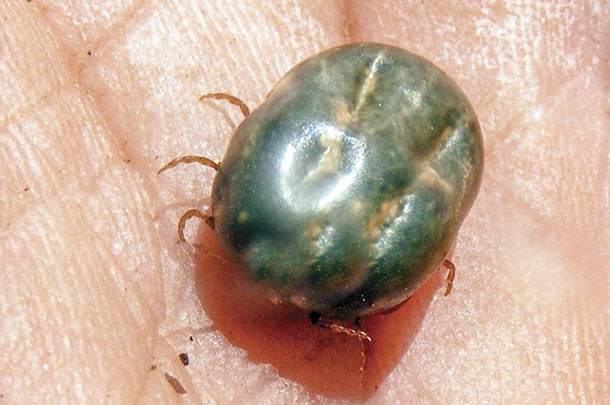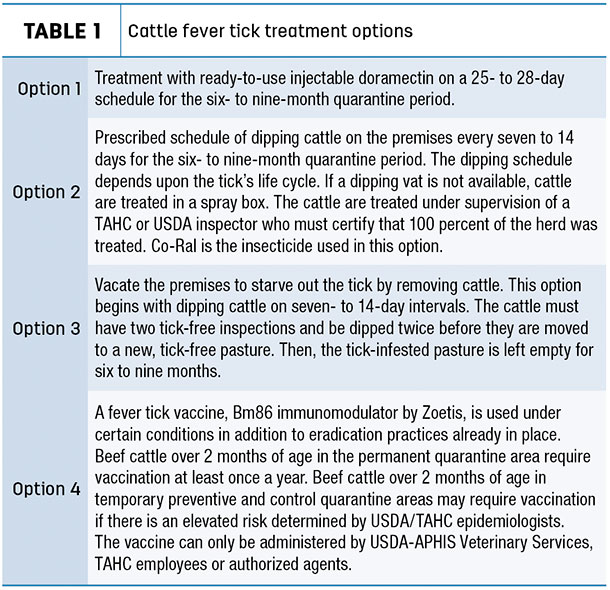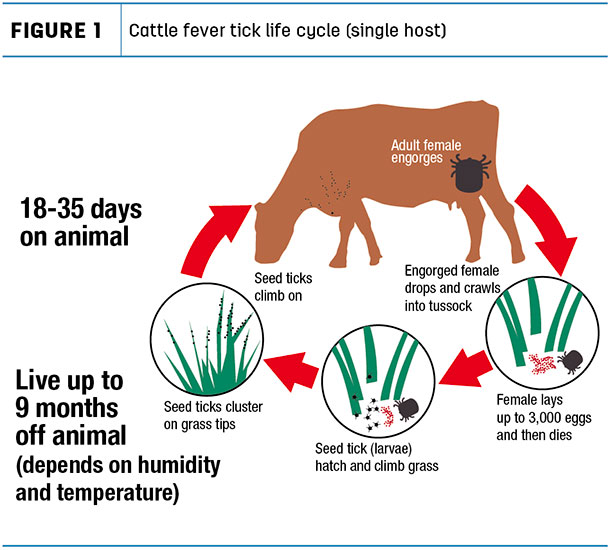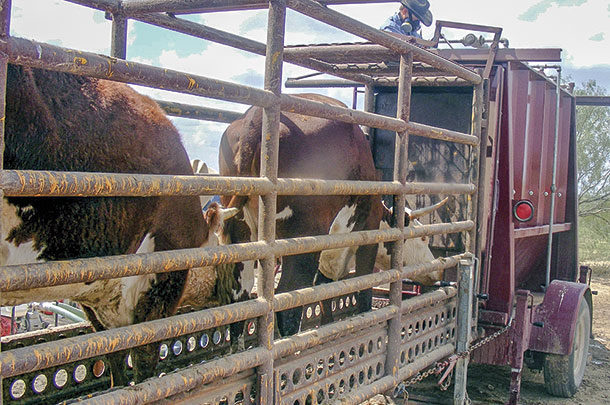If they lose this battle, the entire U.S. cattle population could be affected.
This fight began in 1906 with the launch of a national fever tick eradication campaign. At that time, fever ticks were present in all Southern states bordering Mexico and the Gulf of Mexico and along the Atlantic Coast from the tip of Florida through Virginia.
Due to success of the national program, fever ticks are now confined to a quarantine area along the Rio Grande River from Brownsville to Del Rio. The quarantine area varies in width from 0.2 to 12 miles, is approximately 500 river miles long and contains approximately 500,000 acres.

“The greatest danger to cattle is the fever tick’s capability to carry two species of protozoa (Babesia bovis and B. bigemina) that cause tick fever. When infected fever ticks feed on cattle, they inject protozoa into the bloodstream,” says Dr. Pete Teel, Texas A&M AgriLife Research. “These protozoa attack the animal’s red corpuscles, causing acute anemia and an enlarged liver and spleen.”
Tick fever causes a quick and brutal death in as many as 90 percent of susceptible cattle, and there is no cure available for the fatal disease. Since 1960, fever ticks carrying babesia protozoa have rarely been found in Texas; however, cattle carrying the protozoa are common in Mexico.
Fever tick control
USDA-APHIS and TAHC work together closely in battling fever ticks through a cooperative agreement signed in the late ’70s to early ’80s. TAHC is primarily responsible for surveillance and regulatory functions while APHIS personnel do inspections and treatments. TAHC is also responsible for supplying treatment products.
“Cattle are inspected for fever ticks at import facilities along the Mexico border, at auctions where South Texas cattle are sold, and on ranches in and adjacent to the quarantine zones. Tick inspections are conducted by moving the hands across folds of the skin, behind the legs and along the neck of the animal. This process is referred to as scratching,” says Dr. Andy Schwartz, Texas state veterinarian.
If ticks are found on cattle, the owner has a choice of the three treatment options shown in Table 1. The fourth option in Table 1 is compulsory under certain conditions.

“In areas where dipping vats are not available, portable spray boxes are utilized,” says Schwartz. “The solid steel box is mounted on a two-wheel trailer chassis and has spray nozzles positioned in a manner to spray the entire animal, including its underside. Ramps fold down from each end of the box to serve as cattle entry and exit. The bottom of the spray box contains a metal grate open to a pan that catches runoff spray for reuse or proper disposal.
Each animal receives three 20-second bursts of spray containing Co-Ral insecticide with a few seconds lapse between each burst. Time spent in the spray machine is increased or decreased as needed to ensure the animal is wet to the skin.”
Challenges
During August 2018, the Texas Department of Agriculture (TDA) halted use of spray boxes based on the premise that cattle had died from overexposure to the insecticide. There was immediate pushback from TAHC, Texas and Southwestern Cattle Raisers Association (TSCRA) and Texas Farm Bureau. The three organizations plus USDA-APHIS stated that spray boxes are not known to have caused any cattle deaths due to toxicity nor have they received any reports of such deaths.
They emphasized the facts that TDA’s decision would have detrimental effects on cattle health and ranchers’ livelihoods. The ban was temporarily lifted, and meanwhile, TAHC is working closely with TDA to resolve their concerns.
Winning the war with fever ticks requires development of successful solutions to other challenges, which mostly stem from wildlife. Potential hosts of fever ticks in addition to cattle include horses, white-tailed deer, nilgai antelope and red deer.
“A two-pronged program was developed by USDA-ARS for controlling fever ticks on white-tailed deer. Permethrin is applied topically to deer from paint rollers attached to feeders,” says Mat Pound, USDA-Agricultural Research Service (ARS). “When a deer reaches into the feeder for a kernel of corn, the animal rubs the side of its head, neck and ears against a roller. White-tailed deer are able to lick almost every part of their body. So this gives them the ability to completely groom themselves. After they get permethrin on their neck from a roller, they transfer it to most of their body through grooming.”
A second treatment program authorized for use only by APHIS for fever tick eradication involves feeding ivermectin-treated corn to deer for approximately six months and using topical applications of permethrin during the remainder of the year. The FDA requires withdrawal of the treated feed 60 days prior to hunting. With the length of deer hunting seasons in Texas, there is only a six-month period during which the treated corn can be fed.
“Nilgai antelope are big animals that can carry a lot of ticks,” says Schwartz. “They crawl under fences, travel wide areas and can spread ticks over a lot of geography. Nilgai use a common area to defecate, so a tick parasitic nematode is used in these areas. The problem is that only male parasites are available, which requires constant restocking of the ‘latrine’ areas.”
Other challenges that amplify the tick-laden wildlife problem are changing land use, limited availability of treatments, and constant immigration of wildlife and livestock from Mexico. Due to the opportunity for improved income, many ranches are converting from cattle to both native and exotic wildlife. These animals are harder to treat than cattle and are very active in spreading the fever tick. It is no longer possible to rid a pasture of ticks because of white-tailed deer and nilgai antelope. More effective treatment options are needed for these animals, as well as for cattle and horses.

One of the biggest problems is caused by tick-laden livestock and wildlife crossing the Rio Grande River from Mexico into Texas. A force of approximately 100 tick riders, who are actually USDA inspectors, patrol the river looking for tick hosts crossing the river. If a cow is spotted, the rider ropes the animal and inspects it for ticks. When ticks are found, the animal is treated and quarantined until it is tick-free. White-tailed deer, nilgai and red deer are a bigger problem because it is nearly impossible to catch and treat them.
“Fever ticks in Mexico carry the protozoa, yet Mexican cattle have become immune to tick fever,” says Schwartz. “The biggest threat from tick fever is to cattle in the United States. A border wall would stop migration of livestock and wildlife into the U.S. from Mexico and make eradication of the fever tick in South Texas an easier task.”
The fight to control fever ticks will continue and hopefully, enough money will be appropriated by the federal government to allow development of more effective tools. ![]()
PHOTO 1: The solid steel box is mounted on a two-wheel trailer chassis and has spray nozzles positioned in a manner to spray the entire animal, including its underside.
PHOTO 2: Fever ticks in Mexico carry the protozoa, yet Mexican cattle have become immune to tick fever. The biggest threat from tick fever is to cattle in the United States. Photos courtesy of Texas Animal Health Commission.
Robert Fears is a freelance writer based in Georgetown, Texas. Email Robert Fears.








